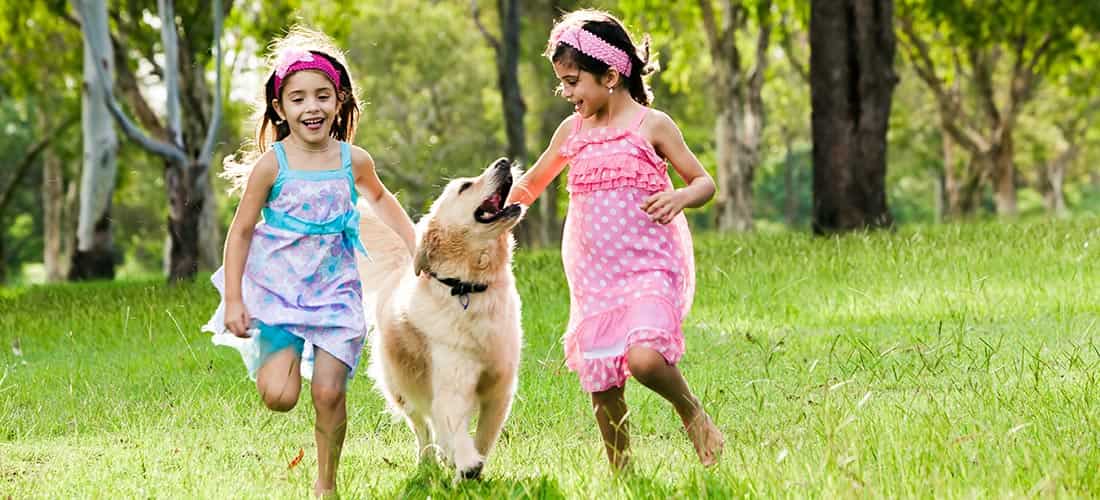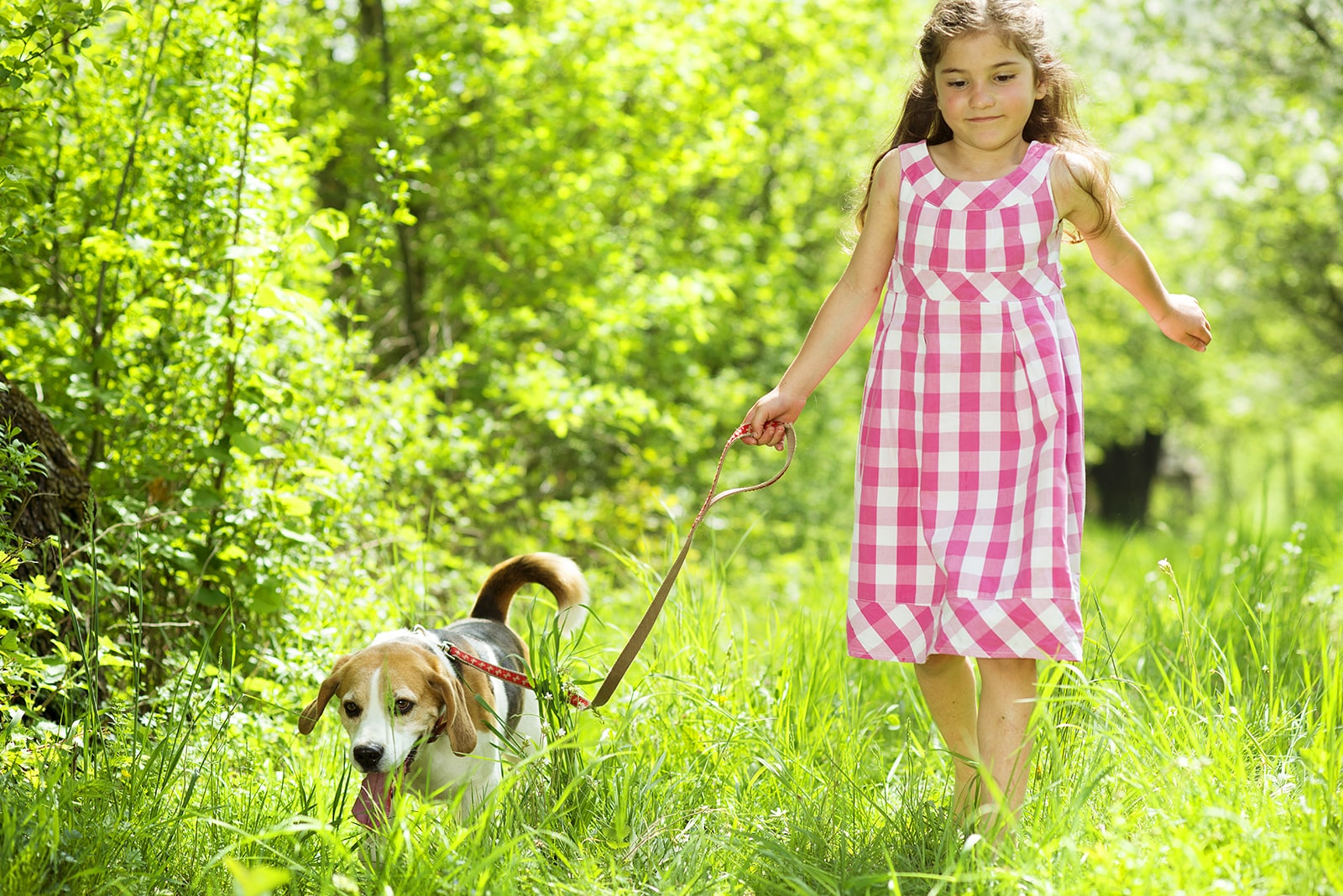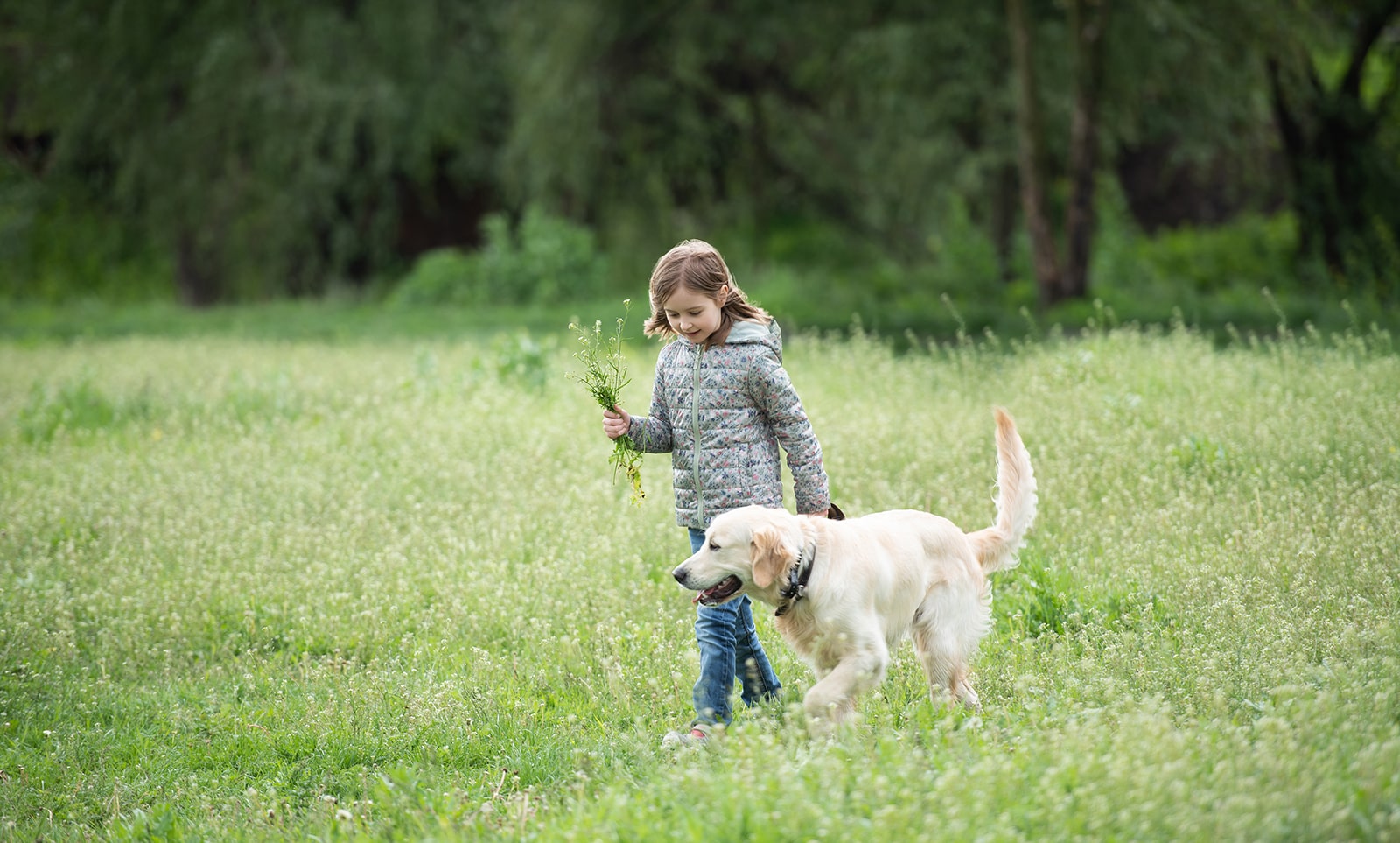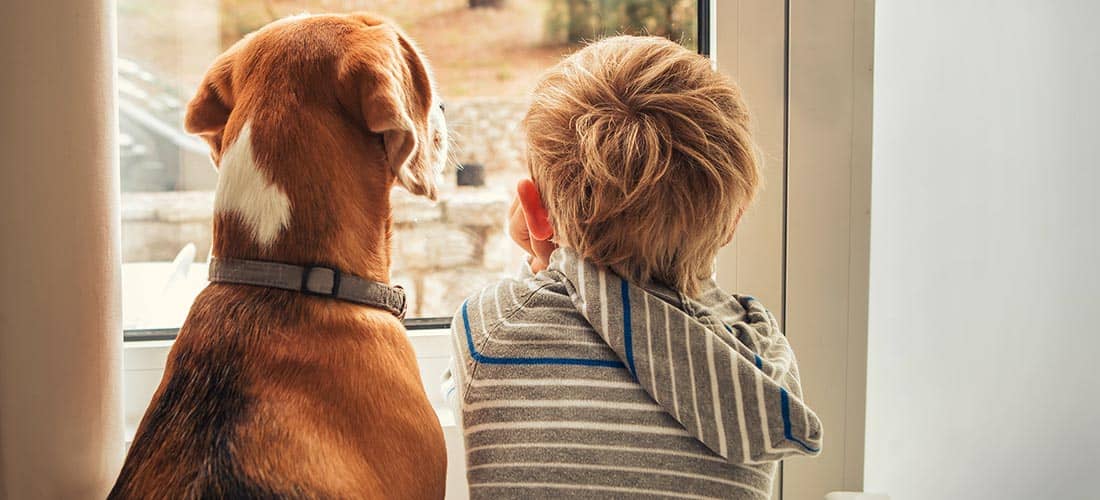Children and dogs: How to keep them happy and safe
Dogs are one of the most popular pets in the UK and are an important part of many family’s lives. Whether you have your own, or just meet the occasional pooch in the park, it’s really important to help your kids learn how to understand and behave around dogs to keep everyone safe and happy, so we’ve created this handy guide.
Choosing the right dog for your family
Having a dog as a family pet can be an amazing experience for children. They can teach children responsibility and empathy, as well as being a great way to get everyone outside, helping to keep the whole family fit and active!
We know that having a dog as part of your family can be amazing for so many reasons, but sadly sometimes accidents happen and children can be seriously injured. One of the main reasons dogs are given up to rescues is because of behaviour problems, which can include aggression. Being able to understand and interact safely with dogs is a very important skill for children to have to keep not only them safe, but also your new four-legged family member.
If you’re looking to get a new puppy or dog, it’s important to do some research before you commit:
- Be honest about the amount of time you’ve got alongside a busy family – is a dog the right pet for you?
- Choose a dog that suits your lifestyle, and that you can fully provide for. Think about their exercise requirements, the amount of stimulation they may need, and their size when fully grown.
For more advice on picking the right pet, take a look at our PetWise Quiz.

As our dogs can’t speak it’s important that we learn to understand their way of communicating! Looking at their body language helps us to understand how our dogs feel.
Young children should never interact with a dog without consent from the owner and very close adult supervision, even with your own family dog. Learn to be aware of and understand your dog’s body language and what they are trying to communicate, so you can make sure they’re not becoming uncomfortable and step in when needed.
Teaching children about consent will help to keep them safe around dogs. If your child wants to interact with a dog, allow the dog to choose to do so rather than the child – they may show this by approaching the child looking relaxed and maybe nudging to engage with them. Monitor them at all times and only allow short gentle interactions. Never let a child approach a dog or take food or a toy from them, even if they know that dog well.
Helping our children to understand and recognise the subtle signs that a dog is feeling uncomfortable, afraid or anxious can be key to keeping them safe around dogs.
Signs a dog is uncomfortable:
- Turning their head away
- Seeing the whites of their eyes
- Being tense
- Having their ears back
- Licking their lips
- Yawning
- Panting
- Pacing around
- Growling or baring their teeth
- Hiding
- Low body posture or cowering.
If a dog your child is interacting with is showing any of the above signs, it’s important they know to leave the dog alone. You can find out more about dog body language in our free guide.
Younger children can be more at risk with dogs because they tend to be more unpredictable. They can be excitable and may shout, scream or try to hug and kiss the dog, often not knowing when to stop and move away. Some dogs can find this attention threatening or frightening and may act defensively.
Hugs and kisses are not a way that dogs communicate with each other, and they can find these behaviours stressful, especially if they come from a child whose body language cues they don’t understand.
Teaching older children to be calm and quiet around dogs will help, but young children should always be a safe distance from dogs. As parents it’s important that you monitor any interactions and intervene as soon as your dog shows the first signs that they are uncomfortable.
Ladder of communication
If a dog is feeling uncomfortable with a situation, they may start to display some body language signals to show that they are anxious and unsure. If these signals are ignored the situation can sadly escalate to the point that the dog may bite. This escalation of frustration to aggression is often known as the ladder of canine communication. However, it is important to highlight that not every dog will show all of these behaviours or in this order.

It’s a good idea to teach children how to safely approach a dog so they don’t scare them. Follow our simple steps:
- Always ask first. When teaching children to approach a dog, always make sure they ask (both you and the dog’s owner).
- Let them come to you and stay calm. Let the dog come to your child and teach them to stay calm as they approach. Get them to throw the dog a treat on the ground, rather than handing it to them – this way the dog doesn’t feel like they have to come close to the child. If the dog is keen to engage with the child, they can then pet them calmly and gently on the back or chest for a couple of seconds whilst monitoring the dog’s behaviour. It’s a good idea to teach children not to touch dogs on their head or face or try to hug them.
- Give them space. Many people believe they should reach their hand out toward a dog, but this can be threatening for the dog and enters their personal space. Make sure children keep their arms by their side when greeting a dog.
- Make sure the dog is happy and comfortable. Once your child has petted the dog, they should stop to give the dog chance to show them if they want to continue being fussed. If the dog moves away or freezes, that’s a sign that the dog doesn’t want to be petted at the moment so it’s important your child can recognise this and move away from them. If the dog pushes their head or body into the child’s hand, seems happy and ‘wiggly’ and keen to continue getting attention then it’s okay to keep petting them.
What to do if a dog approaches your child
If a dog approaches your child in a way they find scary, you can teach them to ‘be a tree’ – stay still and keep their arms close to their body and not make any eye contact, then move slowly to walk away to find an adult.
This will hopefully show the dog that the child is not a threat and is also not someone fun to play with. Try to teach them to avoid running away. This will likely excite that dog and they may think that this is a game.
It is important to remember that a happy dog does not necessarily mean a safe dog. For example, dogs may be in a happy state of mind if they are playing with a toy or chewing but that doesn’t mean it is safe to approach them.
Remember, wild play, running, and jumping may cause a child to get knocked over or injured, so again, always supervise any interactions between dogs and children, no matter how well you know the dog.

When introducing a new dog to your home it’s important to take things slowly and never leave them unattended with your children.
Always start by explaining to your family how they need to behave with a new dog and help your children understand your dog or puppy’s behaviour. With older children, you can discuss the feelings the dog may have in different situations to help build empathy and understand emotions.
Introductions should be done in a calm, comfortable environment. Have your children sit quietly and bring the dog in to meet them. Make sure these experiences are positive for your dog or puppy and children by encouraging your child to throw treats on the floor for them. If your new pet seems stressed or uncomfortable, remove them from the situation, and try again later when they are calm.
Socialising your puppy with children
If you have a new puppy, it’s important to let them interact with children of all ages as part of their socialisation. Always reward your puppy for calm behaviour with a tasty treat or toy. You should always supervise your puppy with children and remove them from the situation if they’re getting afraid or over-excited.
These positive interactions will help your puppy feel less afraid of children and as an adult dog they should be relaxed and happy to be around children. If puppies miss this essential step in their training they can go on to be fearful of children when they’re adult dogs which can lead to conflict.
How to introduce dogs and babies
Introducing a new person to your family can be very daunting for parents, but also for your dog. Try to think of it from their point of view: while restrictions and barriers are extremely valuable to put up around the home, they stop them from accessing areas they could previously get to, they may get less attention, their routine may have changed and a new family addition may be affecting their sleep, too!
We’ve got some tips for welcoming a baby into the home if you already have a dog:
- Change your dog’s routine gradually prior to baby arriving. This means your dog won’t be in for quite such a big surprise when baby comes home.
- When bringing home a baby for the first time, try to stick to your new routine and make sure it includes spending time with your dog. They’ll still need exercise to stop them getting bored so try to factor this into your new routine – it’s a great way to get you all out of the house for fresh air! Alternatively, look for local dog walkers who may be able to help.
- If possible, first introductions between your baby and dog should be when the baby is calm and quiet. Keep the initial interactions short and positive – repeat them regularly to help develop your dog’s confidence.
- If your dog seems afraid support them, give them reassurance, allow them to have his own space and make sure they can get to their toys and bed (or even a den) for comfort.
- If you’re worried about your dog struggling with your new baby it’s worth contacting your vet, vet nurse or certified behaviourist for advice.
- It’s also worth purchasing a few toys which will keep you dog occupied while you’re busy parenting! We’ve got a handy list of activities your dog can do to keep them occupied on our blog.
For more information on introducing a new baby to your pet, check out our free guide.

- Never leave children unattended with a dog – even for a few minutes!
- Dogs may be protective of their toys and bowls or food, so children should always keep a safe distance around these.
- Never let your children approach dogs they don’t know. Always ask the owner if it’s okay for their dog to be petted.
- Train your dog not to jump up on people – it may be fun when they’re a puppy but that cute pup will grow into a much bigger dog that could seriously injure a small child.
- Let sleeping dogs lie – never let children disturb a resting or sleeping dog. Your dog should always have a quiet place they can retreat to when needed.
- Children’s toys are not dog toys! Try to keep your child’s toys separate from your dog’s toys so that your dog learns the difference. Children’s toys can be fun to chew but easily destroyed into little pieces so always be careful that your dog does not swallow anything they shouldn’t.
- Always be careful with the little things your children may leave lying around. Be particularly careful with elastic bands and hair bobbles as children may try to put these on dogs’ legs, ears and around their necks which can lead to serious injuries.
- Do not allow your children to feed your dog while they are eating. This can encourage begging behaviours, or even stealing food from your child’s hand or plate.
- Practice safe hygiene between your dog and children. Pick up any dog poo immediately so your children can’t touch it and always get your children to wash their hands after petting or playing with the dog.
- It’s best to avoid feeding a raw diet if you have children, due to the risk of dangerous bacteria on food bowls and your dog’s mouth. It may be a good idea to worm your dog more regularly if you have young children or are pregnant – speak to your vet about this.
If you notice any behavioural changes in your dog, contact your vet. They can check for a medical issue, give you advice and refer you to a behaviourist if needed. Don’t wait for your dog to bite before taking action!
Where to next?
Puppy prep
Read our free guide on how to prepare your home for the arrival of your four-legged friend.
Dog-friendly homesTraining
It's important to make sure your dog is well-trained, especially if they spend time around children.
Top training tipsSomething special
Your dog will need their own special toys to keep them happy! Take a look at some PDSA-approved toys.
Shop now
